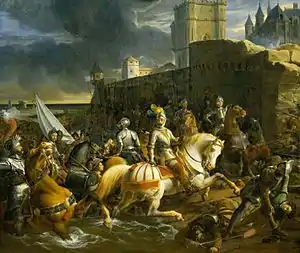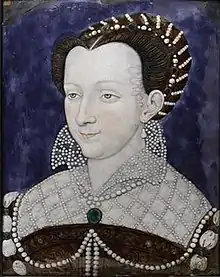Francis, Duke of Guise
Francis de Lorraine II, the first Prince of Joinville, also Duke of Guise and Duke of Aumale (French: François de Lorraine; 17 February 1519 – 24 February 1563), was a French general and politician. A prominent leader during the Italian War of 1551–1559 and French Wars of Religion, he was assassinated during the siege of Orleans in 1563.
Francis | |
|---|---|
| Duc de Guise Duke of Aumale Prince de Joinville | |
 Portrait by François Clouet | |
| Born | 17 February 1519 Bar-le-Duc, Lorraine |
| Died | 24 February 1563 (aged 44) |
| Noble family | Guise |
| Spouse(s) | |
| Issue | |
| Father | Claude, Duke of Guise |
| Mother | Antoinette de Bourbon |
Early life
Born in Bar-le-Duc (Lorraine), Guise was the son of Claude, Duke of Guise (created Duke of Guise in 1527), and his wife Antoinette de Bourbon.[1] His sister, Mary of Guise, was the wife of James V of Scotland and mother of Mary, Queen of Scots.[1] His younger brother was Charles, Cardinal of Lorraine.[1] He was the youthful cousin of Henry II of France, with whom he was raised, and by birth a prominent individual in France, though his detractors emphasised his "foreign" origin (he was a prince étranger), namely the Duchy of Lorraine.
In 1545, he was seriously wounded at the Second Siege of Boulogne, but recovered.[2] He was struck with a lance through the bars of his helmet. The steel head pierced both cheeks, and 15 cm (6 in) of the shaft were snapped off by the violence of the blow. He sat firm in his saddle, and rode back unassisted to his tent; and when the surgeon thought he would die of pain, when the iron was extracted, 'he bore it as easily as if it had been but the plucking of a hair out of his head.' The scar would earn him the nickname "Le Balafre".[2]
In 1548 he was magnificently wedded to Anna d'Este,[3] daughter of the Duke of Ferrara, Ercole II d'Este, and French princess, Renée, the daughter of Louis XII.[4]
Military career


In 1551, he was created Grand Chamberlain of France. He won international renown in 1552 when he successfully defended the city of Metz from the forces of Charles V, Holy Roman Emperor, and defeated the imperial troops again at the Battle of Renty in 1554. but the Truce of Vaucelles temporarily curtailed his military activity.
He led an army into Italy in 1557 to aid Pope Paul IV (and probably to further his family's pretensions to the Angevin inheritance), but was recalled to France and made Lieutenant-General of France[5] after the defeat of the Constable de Montmorency at the Battle of St. Quentin. Taking the field, he captured Calais from the English on 7 January 1558[6]— an enormous propaganda victory for France— then Thionville and Arlon that summer, and was preparing to advance into Luxembourg when the Peace of Cateau-Cambrésis was signed. Throughout the reign of Henry II Guise was the premier military figure of France, courteous, affable and frank, and universally popular, the "grand duc de Guise" as his contemporary Brantôme called him.[lower-alpha 1][7]
The accession of Francis's niece Mary, Queen of Scots, and her husband, Francis II of France (10 July 1559), however, was a triumph for the Guise family, and the Grand Master of France Montmorency was disgraced and sent from court. The Duke of Guise and his brother, Charles, Cardinal of Lorraine were supreme in the royal council.[lower-alpha 2][4] Occasionally he signed public acts in the royal manner, with his baptismal name only.
The Wars of Religion

In reaction to the dominating power at court of the ultra-Catholic Guises, La Renaudie, a Protestant gentleman of Périgord, perhaps at the distanced instigation of Louis of Bourbon, Prince of Condé, organized a plot, the conspiracy of Amboise, to seize the person of the Duke of Guise and his brother Charles, the Cardinal of Lorraine. When the ill-organized plot was put off for six days, it was discovered by the court well ahead of time. On 12 March 1560, the Huguenots stormed the Château d'Amboise, to which the Guises had moved the young king and queen for safety. The uprising was violently suppressed, with 1,200 executed, many within sight of the castle. In the immediate aftermath Condé was obliged to flee the court, and the power of the Guises was supreme. The discourse which Coligny, leader of the Huguenots, pronounced against les Guises in the Assembly of Notables at Fontainebleau (August, 1560), did not influence King Francis II in the least, but resulted rather in the imprisonment of Condé, at Charles's behest.
However, the king died on 5 December 1560—making Mary, Queen of Scots a widow, and of little political importance. The Guises lost status alongside her, thus making a year full of calamity for the Guises both in Scotland and France. Within a year and a half, their influence waxed great and waned. After the accession of Charles IX, the Duke of Guise lived in retirement on his estates.
The regent, Catherine de' Medici, was at first inclined to favour the Protestants. To defend the Catholic cause, the Duke of Guise, together with his old enemy, the Constable de Montmorency and the Maréchal de Saint-André formed the so-called triumvirate opposed to the policy of concessions which Catherine de' Medici attempted to inaugurate in favour of the Protestants. His former military hero's public image was changing: "he could not serve for long as the military executive of this extreme political, ultra-montane, pro-Spanish junta without attracting his share of odium," N. M. Sutherland has observed in describing the lead-up to his assassination.[8]

The plan of the Triumvirate was to treat with Habsburg Spain and the Holy See, and also to come to an understanding with the Lutheran princes of Germany to induce them to abandon the idea of relieving the French Protestants. About July, 1561, Guise wrote to this effect to the Duke of Württemberg. The Colloquy at Poissy (September and October 1561) between theologians of the two confessions was fruitless, and the conciliation policy of Catherine de' Medici was defeated. From 15 to 18 February 1562, Guise visited the Duke of Württemberg at Saverne, and convinced him that if the conference at Poissy had failed, the fault was that of the Calvinists.
As Guise passed through Wassy-sur-Blaise on his way to Paris (1 March 1562), a massacre of Protestants took place.[9] It is not known to what extent he was responsible for this, but the Massacre of Vassy kindled open military conflict in the French Wars of Religion. The siege of Bourges in September was the opening episode, then Rouen was retaken from the Protestants by Guise after a month's siege (October);[10] the Battle of Dreux (19 December), at which Montmorency was taken prisoner and Saint-André slain,[10] was in the end turned by Guise to the advantage of the Catholic cause, and Condé, leader of the Huguenots, was taken prisoner.[10]
Assassination
In the fourth encounter, Guise was about to take Orléans from the Huguenot supporters of Condé when he was wounded on 18 February 1563 by the Huguenot assassin, Jean de Poltrot de Méré, and died six days later, bled to death by his surgeons, at Château Corney.[11]
It was not the first plot against his life. A hunting accident – Francis had been appointed Grand Veneur of France in 1556 – had been planned, as Sir Nicholas Throckmorton informed Queen Elizabeth I of England in May 1560, but the plot was uncovered by one and his five co-conspirators fled.[4]
Guise's unexpected death temporarily interrupted open hostilities. In his testimony, Poltrot implicated Coligny and the Protestant pastor Théodore de Bèze. Though the assassin later retracted his statement and Coligny denied responsibility for Guise's death, a bitter feud arose between Guise's son Henry and Coligny, which culminated in St. Bartholomew's Day massacre.
Family
Guise married Anna d'Este,[3] daughter of Ercole II d'Este, Duke of Ferrara, and Renée of France, in Saint-Germain-en-Laye on 29 April 1548. They had seven children:
- Henry I, Duke of Guise (1550–1588), who succeeded him as Duke of Guise.[1]
- Catherine (18 July 1551, Joinville – 6 May 1596, Paris), married on 4 February 1570 Louis, Duke of Montpensier[1]
- Charles, Duke of Mayenne (1554–1611)[1]
- Louis II, Cardinal of Guise (1555–1588), Archbishop of Reims[1]
- Antoine (25 April 1557 – 16 January 1560)
- François (31 December 1559, Blois – 24 October 1573, Reims)
- Maximilien (25 October 1562–1567)
 Duke Henry I of Guise
Duke Henry I of Guise Catherine de Lorraine
Catherine de Lorraine Duke Charles of Mayenne
Duke Charles of Mayenne Cardinal Louis of Guise
Cardinal Louis of Guise
Ancestry
| Ancestors of Francis, Duke of Guise | |||||||||||||||||||||||||||||||||||||||||||||||||||||||||||||||||||||||||||||||||||||||||||||||||||||||||||||||||||||||||||||||||||||||||||||||||||||||||||||||||||||||||||||||||||||||||||||||||||||||||||||||||||||||||||||||||||||||||||||||||||||||||||||||||||||||||||||||||||||||||
|---|---|---|---|---|---|---|---|---|---|---|---|---|---|---|---|---|---|---|---|---|---|---|---|---|---|---|---|---|---|---|---|---|---|---|---|---|---|---|---|---|---|---|---|---|---|---|---|---|---|---|---|---|---|---|---|---|---|---|---|---|---|---|---|---|---|---|---|---|---|---|---|---|---|---|---|---|---|---|---|---|---|---|---|---|---|---|---|---|---|---|---|---|---|---|---|---|---|---|---|---|---|---|---|---|---|---|---|---|---|---|---|---|---|---|---|---|---|---|---|---|---|---|---|---|---|---|---|---|---|---|---|---|---|---|---|---|---|---|---|---|---|---|---|---|---|---|---|---|---|---|---|---|---|---|---|---|---|---|---|---|---|---|---|---|---|---|---|---|---|---|---|---|---|---|---|---|---|---|---|---|---|---|---|---|---|---|---|---|---|---|---|---|---|---|---|---|---|---|---|---|---|---|---|---|---|---|---|---|---|---|---|---|---|---|---|---|---|---|---|---|---|---|---|---|---|---|---|---|---|---|---|---|---|---|---|---|---|---|---|---|---|---|---|---|---|---|---|---|---|---|---|---|---|---|---|---|---|---|---|---|---|---|---|---|---|---|---|---|---|---|---|---|---|---|---|---|---|---|---|---|---|
| |||||||||||||||||||||||||||||||||||||||||||||||||||||||||||||||||||||||||||||||||||||||||||||||||||||||||||||||||||||||||||||||||||||||||||||||||||||||||||||||||||||||||||||||||||||||||||||||||||||||||||||||||||||||||||||||||||||||||||||||||||||||||||||||||||||||||||||||||||||||||
See also
Notes
- who distinguishes the personal admiration for François, shared by Catherine, from the detestation of les Guises as a faction, led by the brilliant and devious cardinal, whom even the Spanish mistrusted.[7]
- "It is impossible to distinguish the duke's political role from that of his brother, the cardinal."[4]
References
- Carroll 2009, p. 310.
- Johnson & Bongard 1992, p. 301-302.
- Knecht 2016, p. 11.
- Sutherland 1981, p. 280.
- Carroll 2009, p. 80.
- Carroll 2009, p. 80-81.
- Sutherland 1981, p. 281.
- Sutherland 1981, p. 282.
- Knecht 1989, p. 35-36.
- Knecht 1989, p. 37.
- Sutherland 1981, p. 279.
Sources
- Carroll, Stuart (2009). Martyrs and Murderers: The Guise Family and the Making of Europe. Oxford University Press.CS1 maint: ref=harv (link)
- Johnson, C. Curtiss; Bongard, David L. (1992). "Francois de Lorraine, 2nd Duke of Guise". In Dupuy, Trevor N.; Johnson, Curt; Bongard, David L. (eds.). The Harper Encyclopedia of Military Biography. Castle Books.CS1 maint: ref=harv (link)
- Knecht, R.J. (1989). The French Wars of Religion, 1559-1598. Longman Group.CS1 maint: ref=harv (link)
- Knecht, R.J. (2016). Hero or Tyrant? Henry III, King of France, 1574-89. Routledge.CS1 maint: ref=harv (link)
- Sutherland, N. M. (1981). "The Assassination of François Duc de Guise, February 1563". The Historical Journal. Cambridge University Press. 24, June: 279–295.CS1 maint: ref=harv (link)
| French nobility | ||
|---|---|---|
| Preceded by elevated from County by courtesy |
Duke of Aumale 1547–1550 |
Succeeded by Claude |
| Preceded by Claude |
Duke of Guise 1550–1563 |
Succeeded by Henry I |
| Preceded by elevated from Barony |
Prince of Joinville 1552–1563 | |